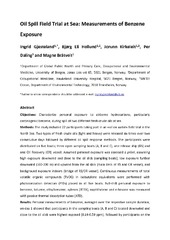| dc.rights.license | Published by Oxford University Press on behalf of the British Occupational Hygiene Society. | |
| dc.contributor.author | Gjesteland, Ingrid | en_US |
| dc.contributor.author | Hollund, Bjørg Eli | en_US |
| dc.contributor.author | Kirkeleit, Jorunn | en_US |
| dc.contributor.author | Daling, Per Snorre | en_US |
| dc.contributor.author | Bråtveit, Magne | en_US |
| dc.date.accessioned | 2017-11-08T13:49:10Z | |
| dc.date.available | 2017-11-08T13:49:10Z | |
| dc.date.issued | 2017-06-08 | |
| dc.Published | Gjesteland I, Hollund BE, Kirkeleit J, Daling PS, Bråtveit M. Oil Spill Field Trial at Sea: Measurements of Benzene Exposure.. Annals of Occupational Hygiene. 2017;61(6):692-699 | eng |
| dc.identifier.issn | 2398-7308 | |
| dc.identifier.issn | 2398-7316 | |
| dc.identifier.uri | https://hdl.handle.net/1956/16915 | |
| dc.description.abstract | Objectives: Characterize personal exposure to airborne hydrocarbons, particularly carcinogenic benzene, during spill of two different fresh crude oils at sea. Methods: The study included 22 participants taking part in an «oil on water» field trial in the North Sea. Two types of fresh crude oils (light and heavy) were released six times over two consecutive days followed by different oil spill response methods. The participants were distributed on five boats; three open sampling boats (A, B, and C), one release ship (RS), and one oil recovery (OR) vessel. Assumed personal exposure was assessed a priori, assuming high exposure downwind and close to the oil slick (sampling boats), low exposure further downwind (100–200 m) and upwind from the oil slick (main deck of RS and OR vessel), and background exposure indoors (bridge of RS/OR vessel). Continuous measurements of total volatile organic compounds in isobutylene equivalents were performed with photoionization detectors placed in all five boats. Full-shift personal exposure to benzene, toluene, ethylbenzene, xylenes, naphthalene, and n-hexane was measured with passive thermal desorption tubes. Results: Personal measurements of benzene, averaged over the respective sample duration, on Day 1 showed that participants in the sampling boats (A, B, and C) located downwind and close to the oil slick were highest exposed (0.14–0.59 ppm), followed by participants on the RS main deck (0.02–0.10 ppm) and on the bridge (0.004–0.03 ppm). On Day 2, participants in sampling boat A had high benzene exposure (0.87–1.52 ppm) compared to participants in sampling boat B (0.01–0.02 ppm), on the ships (0.06–0.10 ppm), and on the bridge (0.004–0.01 ppm). Overall, the participants in the sampling boats had the highest exposure to all of the compounds measured. The light crude oil yielded a five times higher concentration of total volatile organic compounds in air in the sampling boats (max 510 ppm) than the heavy crude oil (max 100 ppm) but rapidly declined to <20 ppm within 24 min after release of oil, indicating short periods of exposure. | en_US |
| dc.language.iso | eng | eng |
| dc.publisher | Oxford University Press | eng |
| dc.relation.ispartof | <a href="http://hdl.handle.net/1956/20523" target="blank"> Oil spill into seawater. Evaporation and human exposure to benzene</a> | |
| dc.subject | benzene exposure | eng |
| dc.subject | cleanup personnel | eng |
| dc.subject | fresh crude oil | eng |
| dc.subject | marine oil spill | eng |
| dc.subject | TVOC | eng |
| dc.title | Oil Spill Field Trial at Sea: Measurements of Benzene Exposure | en_US |
| dc.type | Peer reviewed | |
| dc.type | Journal article | |
| dc.date.updated | 2017-10-03T13:50:27Z | |
| dc.description.version | acceptedVersion | en_US |
| dc.rights.holder | Copyright The Author 2017. | |
| dc.identifier.doi | https://doi.org/10.1093/annweh/wxx036 | |
| dc.identifier.cristin | 1501899 | |
| dc.source.journal | Annals of Occupational Hygiene | |
| dc.source.journal | Annals of Work Exposures and Health | |
| dc.source.40 | 61 | |
| dc.source.14 | 6 | |
| dc.source.pagenumber | 692-699 | |
| dc.subject.nsi | VDP::Medisinske Fag: 700::Helsefag: 800 | en_US |
